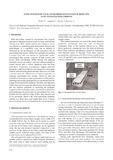Effectiveness of palm and bamboo geotextiles in reducing concentrated flow erosion
Fecha
2007Versión
Acceso abierto / Sarbide irekia
Tipo
Contribución a congreso / Biltzarrerako ekarpena
Versión
Versión publicada / Argitaratu den bertsioa
Impacto
|
|
nodoi-noplumx
|
Resumen
Rills and gullies, caused by concentrated flow erosion,
represent an important sediment source in many environments
(Poesen et al., 2003). Studies indicate that vegetation can be
very effective in controlling gully development. However, the
establishment of a vegetation cover can be delayed or
obstructed by the development of rills and gullies due to
concentrated flow erosion. Before the vegetati ...
[++]
Rills and gullies, caused by concentrated flow erosion,
represent an important sediment source in many environments
(Poesen et al., 2003). Studies indicate that vegetation can be
very effective in controlling gully development. However, the
establishment of a vegetation cover can be delayed or
obstructed by the development of rills and gullies due to
concentrated flow erosion. Before the vegetation has reached
a critical cover and root density to significantly reduce
concentrated flow erosion, a period of high erosion risk
occurs. Hann and Morgan (2006) indicate that applying
geotextiles on the soil surface is the most efficient method to
control erosion until a critical vegetation cover has been
established. Preliminary investigations suggest palm-mat
geotextiles could be an effective and cheap soil conservation
method, with enormous global potential. However, very little
is known about the effectiveness of (palm) geotextiles in
reducing concentrated flow erosion. Almost no data are
available on the impacts of palm geotextiles on the hydraulic,
hydrologic and erosion characteristics of concentrated flow for
a range of environmental conditions. Therefore, the objectives
of this study are (i) to assess the effectiveness of two palm-mat
and one bamboo geotextile in increasing the hydraulic
roughness of the soil surface under concentrated overland flow
and in reducing soil erosion rates by concentrated flow on an
erodible soil type and for a range of flow shear stresses; and
(ii) to investigate which is the most appropriate hydraulic
variable (e.g. shear stress, unit length shear force or stream
power) to predict the net soil detachment by concentrated flow. [--]
Materias
Concentrated flow erosion,
Geotextiles
Editor
Universidad Pública de Navarra / Nafarroako Unibertsitate Publikoa
Publicado en
Javier Casalí, Rafael Giménez (eds.): Progress in Gully Erosion Research. IV International Symposium on Gully Erosion. September 17-19, 2007. Pamplona, Spain. Pamplona: Universidad Pública de Navarra / Nafarroako Unibertsitate Publikoa, 2007
Notas
Resumen del trabajo presentado al IV International Symposium on Gully Erosion, celebrado en la Universidad Pública de Navarra del 17 al 19 de septiembre de 2007.
Entidades Financiadoras
This research is part of the BORASSUS Project: ‘The
environmental and socio-economic contribution of palm-leaf geotextiles to
sustainable development and soil conservation’ (contract number: INCOCT-
2005-510745), funded by the European Commission (EC), Specific
Targeted Research Projects (FP6-STREPs) for Developing Countries
(INCO-DEV) Programme.



